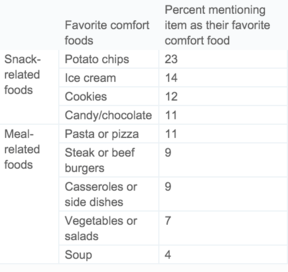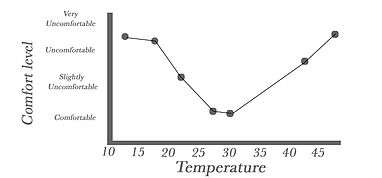Comfort
Comfort (or being comfortable) is a sense of physical or psychological ease, often characterized as a lack of hardship. Persons who are lacking in comfort are uncomfortable, or experiencing discomfort. A degree of psychological comfort can be achieved by recreating experiences that are associated with pleasant memories, such as engaging in familiar activities,[1][2] maintaining the presence of familiar objects,[1] and consumption of comfort foods. Comfort is a particular concern in health care, as providing comfort to the sick and injured is one goal of healthcare, and can facilitate recovery.[3] Persons who are surrounded with things that provide psychological comfort may be described as being "in their comfort zone". Because of the personal nature of positive associations, psychological comfort is highly subjective.[3]

The use of "comfort" as a verb generally implies that the subject is in a state of pain, suffering or affliction, and requires alleviation from that state. Where the term is used to describe the support given to someone who has experienced a tragedy, the word is synonymous with consolation or solace. However, comfort is used much more broadly, as one can provide physical comfort to someone who is not in a position to be uncomfortable. For example, a person might sit in a chair without discomfort, but still find the addition of a pillow to the chair to increase their feeling of comfort. Something that provides this type of comfort, which does not seek to relieve hardship, can also be referred to as being "comfy". Like certain other terms describing positive feelings or abstractions (hope, charity, chastity), comfort may also be used as a personal name.
Concepts

There are various psychological studies about the feeling of comfort, and they have resulted in a few conclusions. The idea of comfort varies among each person; however, there are a few universal themes of comfort that apply to everyone. Most of these universal themes falls under the physical comfort such as contact comfort, comfort food, and thermal comfort.
Contact comfort
Contact comfort is the satisfaction with someone's touch, like a mother's embrace. This is essential to a child's development.
Harry Harlow study
One of the most famous developmental psychological studies is Harry Harlow's development experiment with monkeys. He separated baby monkeys at birth and raised them with surrogate mothers. There were two types of surrogate mothers, a metal wire one and a one covered with cloth, and each had a nozzle that represented breast feeding. The surrogate mother covered in cloth represented comfort. At the end of the experiment, the psychologist saw that the monkeys would choose the cloth surrogate over the wire surrogate. They concluded that having basics needs is essential, but there is the need of closeness and affection.[4]
This experiment justified that importance of comfort and warmth for child development. All the monkeys that grew up from the experiment expressed a behavior of aggression and atypical sexual behaviors.[4]
Comfort food
Comfort foods are foods intentionally consumed to move the eater into a pleasurable state. This could be credited to food preferences and childhood experiences (like a mother's cooking).
Physiological responses
Comfort food are usually chosen because of previous experiences of happiness linked with it. For example, chocolate is held as a popular comfort food as it is follows the pleasurable sweetness and the positive association with gifts/rewards.[5]
The time of day also play a role in consuming comfort foods. Most people tend to eat simply because "it's lunch time" and only 20% of the time is due to actual hunger [6]

Food preferences
Food preferences splits into two categories, snack-related and meal-related. If a child was exposed to many snacks growing up, he/she would focus on more snack-related comfort foods later on in life.[7]
Food preference ranges through male/female, and younger/older. Females and the young demographic prefer snack-related comfort foods, while the male and older demographic prefer meal-related comfort foods.[7]
Thermal comfort

Thermal comfort is a satisfaction of the ambient air temperature and humidity. Psychologists devised a study to determine the most comfortable temperature. The study had people answering a survey as the temperature changed around them. From the surveys, psychologist found many people had no opinion of a range of temperature. This was labeled temperature neutrality, which is the rate as the person metabolism is shifting the same rate as the surrounding temperature. The average comfortable temperature is 30 degrees Celsius. Temperatures too hot (35 °C and above) and temperatures too low (12 °C and below) are considered uncomfortable to many people.[8]
Thermal neutrality
Thermal Neutrality (Thermal Neutral Zone) is the temperature range where it is neither comfortable or uncomfortable. The human body's metabolism is burning calories at the same rate as the temperature around. This would be around 24 °C (room temperature), and people have no opinion about the temperature.[8] Thermal Neutrality is often also used in animal raising. For example, farmers maintain the neutral temperature for cattle to prevent cold stress.[9]
Everyday uses
See also
- Comfort noise, artificial background noise used in radio and wireless communications to fill the silent time in a transmission
- Comfort object, an object used to provide psychological comfort
- Comfort women, a euphemism for women who were forced to work as sex slaves in Japanese-occupied countries during World War II
- Comfort zone, the term used to denote a type of mental conditioning resulting in artificially created mental boundaries, within which an individual derives a sense of security
- Consolation
- Contentment
- Pleasure
- Katharine Kolcaba, The Theory of Comfort, a mid-range nursing theory
References
- Daniel Miller, The Comfort of Things (2009).
- Abbott, Abbott, Bellamy, Mabie, Ernest Hamlin, Lyman, Francis Rufus, Hamilton Wright (1919). "The Outlook, Volume 121". The Outlook, Volume 121. Outlook Co., 1919. 121: 429.CS1 maint: multiple names: authors list (link)
- Katharine Kolcaba, Comfort Theory and Practice: A Vision for Holistic Health Care and Research (2003).
- "Psychology History". muskingum.edu. Archived from the original on 2016-12-07. Retrieved 2016-01-29.
- Barthel, Diane (August 1989). "Modernism and Marketing: The Chocolate Box Revisited". Theory, Culture & Society. 6 (3): 429–438. doi:10.1177/026327689006003004.
- TUOMISTO, T; TUOMISTO, MT; HETHERINGTON, M; LAPPALAINEN, R (1998-04-01). "Reasons for Initiation and Cessation of Eating in Obese Men and Women and the Affective Consequences of Eating in Everyday Situations". Appetite. 30 (2): 211–222. doi:10.1006/appe.1997.0142. PMID 9573454.
- Wansink, Brian; Cheney, Matthew M.; Chan, Nina (2003-09-01). "Exploring comfort food preferences across age and gender". Physiology & Behavior. 79 (4–5): 739–747. doi:10.1016/S0031-9384(03)00203-8. PMID 12954417.
- Gagge, A. P.; Stolwijk, J. A. J.; Hardy, J. D. (1967-06-01). "Comfort and thermal sensations and associated physiological responses at various ambient temperatures". Environmental Research. 1 (1): 1–20. doi:10.1016/0013-9351(67)90002-3.
- "Explain the concepts of thermoneutral zone, lower critical temperature, and upper critical temperature, and how they relate to metabolic rate - eXtension". articles.extension.org. Retrieved 2016-02-01.
- "Ventilation | Department of Energy". energy.gov. Retrieved 2016-02-01.
External links
| Wikiquote has quotations related to: Comfort |
| Look up comfort in Wiktionary, the free dictionary. |